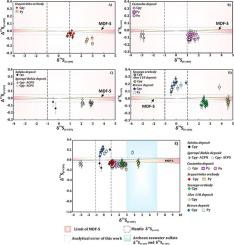当前位置:
X-MOL 学术
›
Ore Geol. Rev.
›
论文详情
Our official English website, www.x-mol.net, welcomes your
feedback! (Note: you will need to create a separate account there.)
Multiple Sulfur Isotopes Constraints on Origin and Evolution of the Neoarchean and Paleoproterozoic Cu-Au Systems from the Carajás Domain, Amazonian Craton, Brazil
Ore Geology Reviews ( IF 3.2 ) Pub Date : 2021-02-01 , DOI: 10.1016/j.oregeorev.2020.103872 E.S.B. Santiago , R.P. Xavier , S.G. Hagemann , L.V.S. Monteiro , J. Cliff
Ore Geology Reviews ( IF 3.2 ) Pub Date : 2021-02-01 , DOI: 10.1016/j.oregeorev.2020.103872 E.S.B. Santiago , R.P. Xavier , S.G. Hagemann , L.V.S. Monteiro , J. Cliff

|
Abstract Multiple sulfur isotopes in sulfides were measured by in situ Secondary Ion Mass Spectrometry in order to constrain sulfur sources and pathways, as well as explore atmosphere–ore genesis implications on the metallogeny of the Neoarchean and Paleoproterozoic Cu-Au systems of the Carajas Domain, southeast Amazonian Craton, Brazil. All of the investigated Neoarchean (2.70–2.57 Ga; i.e., Salobo, Igarape Bahia, Castanha and Sequeirinho) and Paleoproterozoic IOCG (ca 1.88 Ga; i.e., Alvo 118 and Sossego) deposits show Δ33S 0‰ (+0.08‰ to + 0.27‰), implying that sulfur underwent mass-independent fractionation (MIF). In addition, three distinct δ34S ranges are defined: −3.07‰ to + 3.01‰ and + 2.17‰ to + 4.68‰ for the Neoarchean and Paleoproterozoic IOCG deposits, respectively, and −0.46‰ to + 3.81‰ for the Paleoproterozoic Breves deposit. In the Neoarchean IOCG deposits, sulfur is most likely of mantle/magmatic origin. However, a subtle but detectable MIF-S signature reflects the inheritance of a minor sulfur component transported to the atmosphere, experienced photolytic reactions and returned to the hydrosphere. The interaction between highly saline, hot, and deep-seated metalliferous fluids with the host rocks, including sulfate-bearing volcanic rocks that underwent seafloor alteration, may account for the small negative Δ33S values in the IOCG deposits. The similarity between the negative Δ33S signatures of the Neoarchean and the Paleoproterozoic IOCG deposits (i.e., Sossego and Alvo 118) suggest that the MIF signatures recorded by the latter most likely reflect inheritance of Neoarchean sulfur with MIF signatures acquired by large scale fluid-rock interaction triggered by the ca 1.88 Ga A-type granitic magmatism. The positive Δ33S values of sulfides from the Paleoproterozoic Breves deposit, in contrast, were probably generated by reduced sulfur species sourced from crustal sources (e.g., Archean pyrite-bearing sedimentary units) in addition to magmatic sulfur related to ca. 1.88 Ga A-type granite emplacement.
中文翻译:

多硫同位素对巴西亚马逊克拉通 Carajás 域新太古代和古元古代 Cu-Au 系统起源和演化的约束
摘要 为了限制硫的来源和途径,以及探索大气-矿石成因对 Carajas 域新太古代和古元古代 Cu-Au 系统成矿的影响,通过原位二次离子质谱法测量了硫化物中的多种硫同位素,巴西亚马逊克拉通东南部。所有调查的新太古代(2.70–2.57 Ga;即,Salobo、Igarape Bahia、Castanha 和 Sequeirinho)和古元古代 IOCG(约 1.88 Ga;即 Alvo 118 和 Sossego)矿床都显示 Δ33S 0‰ (+0.082 to‰) ),这意味着硫经历了与质量无关的分馏 (MIF)。此外,还定义了三个不同的 δ34S 范围:分别为新太古代和古元古代 IOCG 矿床的 -3.07‰ 至 + 3.01‰ 和 + 2.17‰ 至 + 4.68‰,以及古元古代 Breves 矿床的 -0.46‰ 至 + 3.81‰。在新太古代 IOCG 矿床中,硫最有可能是地幔/岩浆成因。然而,一个微妙但可检测的 MIF-S 特征反映了传输到大气中、经历光解反应并返回到水圈的少量硫成分的遗传。高盐度、热和深层含金属流体与主岩(包括经历海底蚀变的含硫酸盐火山岩)之间的相互作用可能是 IOCG 矿床中较小的负 Δ33S 值的原因。新太古代和古元古代 IOCG 沉积物的负 Δ33S 特征之间的相似性(即,Sossego 和 Alvo 118) 表明后者记录的 MIF 特征最有可能反映了新太古代硫的遗传,其中 MIF 特征是由约 1.88 Ga A 型花岗岩岩浆作用引发的大规模流体-岩石相互作用获得的。相比之下,来自古元古代 Breves 矿床的硫化物的正 Δ33S 值可能是由来自地壳来源(例如,含太古代黄铁矿的沉积单元)的还原硫物种以及与约 1.88 Ga A 型花岗岩就位。
更新日期:2021-02-01
中文翻译:

多硫同位素对巴西亚马逊克拉通 Carajás 域新太古代和古元古代 Cu-Au 系统起源和演化的约束
摘要 为了限制硫的来源和途径,以及探索大气-矿石成因对 Carajas 域新太古代和古元古代 Cu-Au 系统成矿的影响,通过原位二次离子质谱法测量了硫化物中的多种硫同位素,巴西亚马逊克拉通东南部。所有调查的新太古代(2.70–2.57 Ga;即,Salobo、Igarape Bahia、Castanha 和 Sequeirinho)和古元古代 IOCG(约 1.88 Ga;即 Alvo 118 和 Sossego)矿床都显示 Δ33S 0‰ (+0.082 to‰) ),这意味着硫经历了与质量无关的分馏 (MIF)。此外,还定义了三个不同的 δ34S 范围:分别为新太古代和古元古代 IOCG 矿床的 -3.07‰ 至 + 3.01‰ 和 + 2.17‰ 至 + 4.68‰,以及古元古代 Breves 矿床的 -0.46‰ 至 + 3.81‰。在新太古代 IOCG 矿床中,硫最有可能是地幔/岩浆成因。然而,一个微妙但可检测的 MIF-S 特征反映了传输到大气中、经历光解反应并返回到水圈的少量硫成分的遗传。高盐度、热和深层含金属流体与主岩(包括经历海底蚀变的含硫酸盐火山岩)之间的相互作用可能是 IOCG 矿床中较小的负 Δ33S 值的原因。新太古代和古元古代 IOCG 沉积物的负 Δ33S 特征之间的相似性(即,Sossego 和 Alvo 118) 表明后者记录的 MIF 特征最有可能反映了新太古代硫的遗传,其中 MIF 特征是由约 1.88 Ga A 型花岗岩岩浆作用引发的大规模流体-岩石相互作用获得的。相比之下,来自古元古代 Breves 矿床的硫化物的正 Δ33S 值可能是由来自地壳来源(例如,含太古代黄铁矿的沉积单元)的还原硫物种以及与约 1.88 Ga A 型花岗岩就位。









































 京公网安备 11010802027423号
京公网安备 11010802027423号